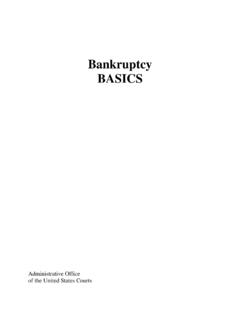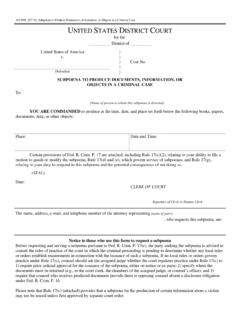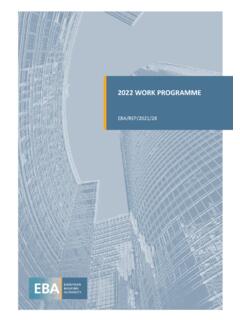Transcription of The Effectiveness of Prison Programming: A Review of the ...
1 3 June 2020 The Effectiveness of Prison programming : A Review of the Research Literature Examining the Impact of Federal, State, and Local Inmate programming on Post-Release Recidivism* James M. ByrneUniversity of Massachusetts at LowellOn behalf of the First Step Act Independent Review CommitteeDec. 2019 About the First Step Act Independent Review CommitteeTitle I 3631-3633 (inclusive) of Public Law 115-391 (December 21, 2018), com-monly referred to as the First Step Act (FSA), assigns the Attorney General (AG) of the United States two principal responsibili-ties. In consultation with the Director of the Bureau of Prisons (BOP), the Director of the Administrative Office of the Courts, the Director of the Office of Probation and Pretrial Services, the Director of the National Institute of Justice (NIJ), and the Director of the National Institute of Corrections (NIC), the AG is directed to: Develop, validate, release for public Review (by late July 2019), and implement (through BOP by late January 2020) FSA s risk and needs assessment system (RNAS) provisions.
2 And Identify effective evidence-based recid-ivism-reduction programs (EBRPs) and productive activities for BOP inmates; expand inmate access to such programs and activities (by late January 2020) as necessary to implement FSA Title I s sys-tem of time-credit incentives for inmate participation; and further expand inmate access to such programs and activities such that (by late January 2022) EBRPs and productive activities are available for all prisoners in BOP custodyTo assist the AG in the performance of these duties, FSA s Title I 107 provides for the estab-lishment of an Independent Review Committee (IRC) composed of not fewer than six individu-als with expertise in risk and needs assessment systems (including at least two who have pub-lished peer-reviewed scholarship on the subject.)
3 Two current or former corrections practitio-ners one of them with prior work experience inside BOP who have developed and admin-istered risk and needs assessment tools; and one with particular expertise in evaluating the implementation of such tools). NIJ is to select a nonpartisan and nonprofit organization with expertise in the study and development of risk and needs assessment tools that will then select and appoint the IRC s member experts and act as the Committee s host until its statutory ten-ure ends two years after the date on which the RNAS is initially more information, visit About the AuthorDr.
4 James M. Byrne, is Professor and Associate Chair at the School of Criminology and Justice Studies at the University of Massachusetts Lowell, and Director of the Global Community Corrections Initiative. Professor Byrne received his undergradu-ate degree in Sociology from the University of Massachusetts, Amherst (1977) and his Masters (1980) and Doctoral degree (1983) in Criminal Justice from Rutgers Byrne has conducted many evaluations of justice initiatives and programs, includ-ing over twenty separate process and impact evaluations using a variety of research designs, survey methods, and analytic techniques.
5 His research portfolio includes studies of federal sentencing guidelines, intermediate sanc-tions, offender reentry, drug testing in federal pretrial systems, domestic violence control, drug treatment, day reporting centers, drunk driving interventions, absconder location/apprehension strategies, sex offender moni-toring/location technology, suicide prevention among alleged sex crime defendants, Prison violence prevention and control, and the impact of the National Institute of Corrections Institutional Culture Change work in the area of evidence-based * Originally published by Hudson Institute, The First Step Act Independent Review Committee s host organization under a grant from the Dept.
6 Of FEDERAL PROBATIONV olume 84 Number 1corrections practices has received national and international recognition. In 2011, Professor Byrne was the recipient of both the Distinguished Scholar Award and the Marguerite Q. Warren and Ted Palmer Differential Intervention Award from the American Society of Criminology s Division on Corrections and Sentencing. He has provided testimony on the Effectiveness of community sanctions before Congress and the Sentencing Byrne is the editor-in-chief of the jour-nal, Victims and Offenders: An International Journal of Evidence-based Research, Policy, and Practice.
7 He also serves on the editorial boards of Criminology and Public Policy and the european Journal of Probation, and on National Advisory Committee for Federal Probation, a publication of the Administrative Office of the Courts. Dr. Byrne has served as an expert panelist for the Ministry of Justice UK s Correctional Services Advisory and Accreditation Panel since 2012. He was also the External Inspector of Prisons for the Queensland Correctional Services Office of the Inspector General in 2014, where he con-ducted an independent Review of its Prison assault problem across twelve First Step Act emphasizes the importance of BOP programming as a recidivism reduc-tion strategy and includes sentence-reduction incentives for eligible inmates who partici-pate in evidence-based recidivism reduction programs.
8 This memorandum reviews avail-able research about the recidivism reduction effects of federal, state, and local Prison pro-gramming in an attempt to determine to what extent such programming can fairly be described as evidence-based. There are three distinct types of reviews that can be used to establish evidentiary criteria and determine what works in the area of Prison program-ming (Byrne & Lurigio, 2009).The most rigorous such Review would focus narrowly on the results of high qual-ity, well-designed randomized control trials (RCTs) conducted during a specified period. A minimum of two RCTs demonstrating Effectiveness (and a preponderance of lower-level research studies producing similar results) would be necessary before a deter-mination could be offered about whether a particular program or strategy worked.
9 This is the type of Review strategy and scientific evidence relied on in the hard A second Review strategy allows identification of a program as evidence-based (or working) if there are at least two quasi-experimental stud-ies with positive findings, and the majority of lower-quality studies point in the same direc-tion. This is the approach used in the reviews produced by the Campbell Collaborative. A variation on this approach representing a third type of evidence-based Review is found on the DOJ website, where a program will be described as effective based on a rating of each applicable research study by two independent To b e rated as effective, at least one high-quality evaluation RCT or well-designed quasi-experiment needs to be identified.
10 This article adopts the second standard described above to summarize the research under Review (see Appendix B), but we have also examined all studies and reviews of Prison programs identified by in this Review is a careful look at the available evaluation research on the BOP programming , focusing on the 18 national model Prison programs identified by Also included in this Review is an examina-tion of the much larger body of evaluation research conducted on the recidivism reduc-tion effects of state and local Prison programs, offering summary assessments of all relevant evaluation research and corresponding rec-ommendations for DOJ and BOP to consider as they move to implement high-quality.












